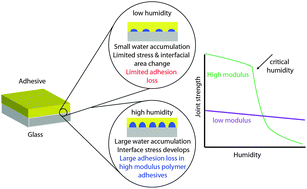Mechanisms of criticality in environmental adhesion loss†
Abstract
Moisture attack on adhesive joints is a long-standing scientific and engineering problem. A particularly interesting observation is that when the moisture level in certain systems exceeds a critical concentration, the bonded joint shows a dramatic loss of strength. The joint interface plays a dominant role in this phenomenon; however, why a critical concentration of moisture exists and what role is played by the properties of the bulk adhesive have not been adequately addressed. Moreover if the interface is crucial, the local water content near the interface will help elucidate the mechanisms of criticality more than the more commonly examined bulk water concentration in the adhesive. To gain a detailed picture of this criticality, we have combined a fracture mechanics approach to determine joint strength with neutron reflectivity, which provides the moisture distribution near the interface. A well-defined model system, silica glass substrates bonded to a series of polymers based on poly(n-alkyl methacrylate), was utilized to probe the role of the adhesive in a systematic manner. By altering the alkyl chain length, the molecular structure of the polymer can be systematically changed to vary the chemical and physical properties of the adhesive over a relatively wide range. Our findings suggest that the loss of adhesion is dependent on a combination of the build-up of the local water concentration near the interface, interfacial swelling stresses resulting from water absorption, and water-induced weakening of the interfacial bonds. This complexity explains the source of criticality in environmental adhesion failure and could enable design of adhesives to minimize environmental failure.


 Please wait while we load your content...
Please wait while we load your content...